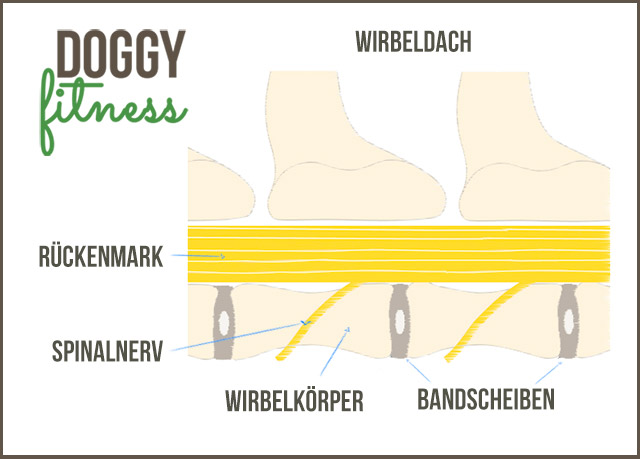The spine of the dog
How is the spine of the dog actually built? We’re going to take a little trip into anatomy. Anatomy is boring? I don’t think so! Above all, some knowledge about the dog’s anatomy, its movement and also possible diseases will help you to understand better. At the same time, it also provides clarity on why various movements and stresses are unhealthy for your dog and promote the development of disease. The spine of the dog is quite similar to that of humans. The difference that is most obvious to everyone is that in humans it is in the vertical. In the dog, on the other hand, it is horizontal.
But what is the structure of the spine of the dog?
The spine consists of individual vertebrae strung together. These in turn consist of the vertebral body and the vertebral roof. They look different depending on their function. Some have short, compact vertebral bodies, while others have long vertebral bodies. The various processes on the vertebral roof can also be pronounced differently. By the way, the spinous processes on top of the vertebral roof are palpable for us. You can easily test it by lightly sliding your fingers down the center of your back.

How many vertebrae does the dog have?
The number of vertebrae varies slightly in humans and dogs. Thus, dogs and humans each have 7 cervical vertebrae. But the dog has 13 thoracic vertebrae, one more than we humans. In the lumbar spine, there are 7 vertebrae, which is 2 vertebrae more. The sacrum is common to both of us. Then, however, the difference is serious. While humans have one coccyx, dogs have 20-23 caudal vertebrae.
How are the vertebrae related?
The individual vertebrae are connected to each other by small joints called facet joints. They ensure the mobility. The whole is surrounded by ligaments and muscles. They give support. Intervertebral discs are found between the vertebrae. They have an important shock absorber function.
The spinal canal protects the important spinal cord
In the vertebral canal, which is formed by the vertebral bodies and vertebral roofs lined up next to each other, the spinal cord runs well protected. Between the individual vertebrae, nerves emerge at various points through so-called nerve exit holes. Nerves have different functions. For example, they provide the tension and relaxation of the various muscles. This also enables locomotion.
Cauda Equina – how it gets its name
At the end of the spinal cord, at the level of the last lumbar vertebra, at the transition to the sacrum, the so-called cauda equina emerges. A bundle of nerves that looks like a horse’s tail. That is where the name comes from. In conditions such as cauda equina compression syndrome, pressure is placed on this nerve tail by a variety of causes. As similar as the canine spine is to the human spine, so are the diseases that can affect it. These include, for example, conditions such as herniated discs or spondylosis. However, it is difficult to recognize them. We humans express pain clearly. Our four-legged friend cannot tell us when he is suffering from back pain. So we have to train our eyes to interpret possible signs correctly. I’ll tell you common signs of back pain in dogs in my next article!
Dieser Beitrag ist auch verfügbar auf:
Français (French)
Deutsch (German)
Español (Spanish)















